A series of neatly aligned posters coat the walls of an underpass in a quiet residential corner of Sha Tin. “Withdraw the evil sending to China law, release the detained,” reads each replica, printed in bold, primary colours and accompanied by an illustration of a stick figure being beaten by another wearing a police hat. The design is by any measure eye-catching. But it is one of a number that has blossomed out of Hong Kong’s anti-extradition law movement.
Often made with speed and enviable talent, the city’s protest posters have gained prominence for their wry, caustic humour and at times poignant nod to tragic events. The dramatic signs that call people to the streets are also chock-full of cross-referential winks that document the movement as it snowballs across the city.

Hong Kong has been rocked by weeks of protests sparked by a reviled extradition bill, which would enable the chief executive and courts to handle fugitive transfer requests to jurisdictions where there are no prior agreements – such as China – without legislative oversight. The city’s embattled leader declared the bill “dead,” but stopped short of its complete withdrawal as per protester demands.
The demonstrations have since morphed into a wider display of discontent over alleged police misconduct related to the use of crowd control measure, the Chief Executive Carrie Lam, and democratic freedoms, among other demands. The political crisis has led to unprecedented scenes of unrest, including the use of rubber bullets against protesters on June 12 and crowds storming the Legislative Council on July 1, vandalising its interior.
The following is a selection of recent poster designs reflecting protesters’ evolving demands:
‘Oppose sending to China’
In March, the Cantonese phrase for “Oppose sending to China” began to gain traction as the rallying cry of anti-extradition law protesters. Trisyllabic and punchy, the last two characters are also a witty homonym which means “to see off a dying relative,” implying the death of Hong Kong.

Author Antony Dapiran told HKFP that the slogan captures the identity politics tied up with the bill: “It’s easy to chant, obviously, and easy to reproduce It goes to the core of the issue which, yes, it was against the extradition bill and all the complex legal technicalities that are tied up with that. But at the very heart of the concern was people didn’t want to be sent back to China to face trial,” he said. “[Meaning]: ‘We are not China, we are against being sent to China, we want to be Hong Kong’.”
A poster from political group Demosistō, posted to Facebook on May 7, showed a striking image of Lam combined with a half-skeletal tiger, holding a roll of cable in its jaw – a reference to the proposed extradition law. Underneath read: “Say NO to totalitarian judiciary… WITHDRAW THE EXTRADITION LAW AMENDMENT… Oppose sending to China.”

Chairman Ivan Lam, who designed the poster, told HKFP he wanted to illustrate the danger of the bill: “The graphic was inspired by [the] Cantonese phrase ‘送羊入虎口’ (sung joeng jap fu hau), which means sending a lamb into a tiger’s mouth, or putting someone in extreme danger,” he said. “I used the image as a metaphor [for] China extradition law, which threatens Hongkongers’ safety and freedom.”
The Civil Human Rights Front, which had organised several anti-extradition protests, came out with a poster to call people out to the streets on June 9. The design resembled a comic book, only between the lines lay foreboding images of mainland courts, with 1989 Tiananmen Square democracy activist Li Wang-yang in the top left corner, who was found dead in 2012 in what friends and activists purported to be a fake suicide.
Underneath the images read: “Defend Hong Kong,” “Withdraw the evil law,” and “Carrie Lam resign.”

Carlos Hung Chun-ngai, who designed the poster, told HKFP he wanted to convey the injustice of the mainland legal system: “What the images represent is related to the anti-extradition movement. There were many activists and human right lawyers arrested and detained under the iron fist of [Chinese President] Xi Jinping,” he said. “We are able to access this information in Hong Kong because we still live in a city that enjoys press freedom and freedom of speech. At the same time, these incidents are the reason why Hongkongers refuse to trust the Chinese judicial system.”
“I wanted to remind Hong Kong people of the horror of an uncivilised judicial system and also to honour Chinese activists who tirelessly fought against tyranny. It is a struggle between remembrance and oblivion,” he added.
Hung said he chose the colour red as it is often used to symbolise the Chinese Communist Party in propaganda.
‘One more person’
Another design showed several figures in a crowd saying “One more person won’t make a difference,” followed by the line “One more is actually a lot.” The sign was part of a drive to call more people out to attend an anti-extradition bill march organised by Civil Human Rights Front (CHRF).

The campaign appeared to have paid off. CHRF said over a million people – many of whom were first-time protesters – attended the march on June 9, though police put the figure at 240,000. The rally was followed by another the Sunday on June 16 after attended by “two million,” making it the largest rally in Hong Kong’s history. Police put the turnout estimate at 338,000.
Labour strike
As momentum for the anti-extradition movement built, individual businesses were called upon to protest the much-hated bill. On June 12, over 100 employers from across industry sectors pledged to either suspend business or support employees who chose to participate in a rare mass labour strike, accompanied by a students’ strike.

Mothers (and fathers)
After repeated calls to withdraw the extradition bill and resign as Chief Executive, Lam said that as a mother, she could not give in every time her son makes a demand. The parenting analogy prompted ridicule from members of the public who rejected the leader as their mother.

A sign promoting a rally on June 16 read “‘Suspend your mother’ mass march” – a pun on a police officer’s insult “Journo your mother” against a reporter, along with a reference to the government’s suspension of the extradition bill which protesters have refused to accept as a withdrawal.

We’ve had the mums, next up, it’s the dads. Sunday #NoChinaExtradition march coincides with Father’s Day. This says, among other things, “All HK dad’s stiffen up” and “Remember your dad” (play on cop swearing at journalist ‘journ-yourmum’) pic.twitter.com/eOTbZuyCLq
— Yuen Chan (@xinwenxiaojie) June 14, 2019
“Don’t shoot our kids” was the leading cry of a protest against alleged police brutality on June 12, which saw 150 tear gas canisters, “several” rounds of rubber bullets, and 20 beanbag shots fired towards demonstrators – figures that dwarfed the 87 rounds of tear gas canisters used during the 2014 mass democracy protests.

A call for #HongKong people to go to Admiralty to protest #ExtraditionBill on Friday … in the form of a traditional wedding invite, for the marriage of (homonyms of) Hong Kong and Freedom. Breakfast, 7pm picnic, 8pm banquet. Note:@OCLPHK also referred to “banquet” as euphemism pic.twitter.com/y5BUfIttiZ
— Yuen Chan (@xinwenxiaojie) June 20, 2019
G20 push
Protesters mobilised to urge G20 countries to voice concern about Hong Kong at the leaders’ summit in Osaka, Japan, between June 28 and 29. The meeting saw world leaders from the European Union and 19 countries with the largest economies convene to discuss pressing financial and economic issues. Chinese President Xi Jinping was among those attending.
The campaign began with a mass march to 19 foreign consulates on June 26 to hand in petition letters to country representatives. An English-language poster publicising the event depicted an unidentified figure dashing across Central en route to the embassies.

Another poster inscribed with “Free Hong Kong, democracy now,” which advertised a CHRF rally later in the day, saw a shift in tone from earlier extradition-related protests to explicit calls for democracy, made in both Cantonese and English – a decision, design volunteer Brandon Yau, told HKFP was deliberate given the campaign’s international focus.
“We were anticipating the international community to step up for Hong Kong during G20 summit, and at that time there was a massive campaign from LIHKG for international advertisement,” he said. “We decided the June 26 assembly poster should address both solidarity with the world and our local online community. This was the only mass assembly in the anti-extradition movement in which English was the main language.”
The design, done by a team of volunteers, made use of red as both striking and the “colour of struggle,” Yau said. “We want to give a simple message to the world – we are not standing here and waiting for aid. We shall never surrender!”
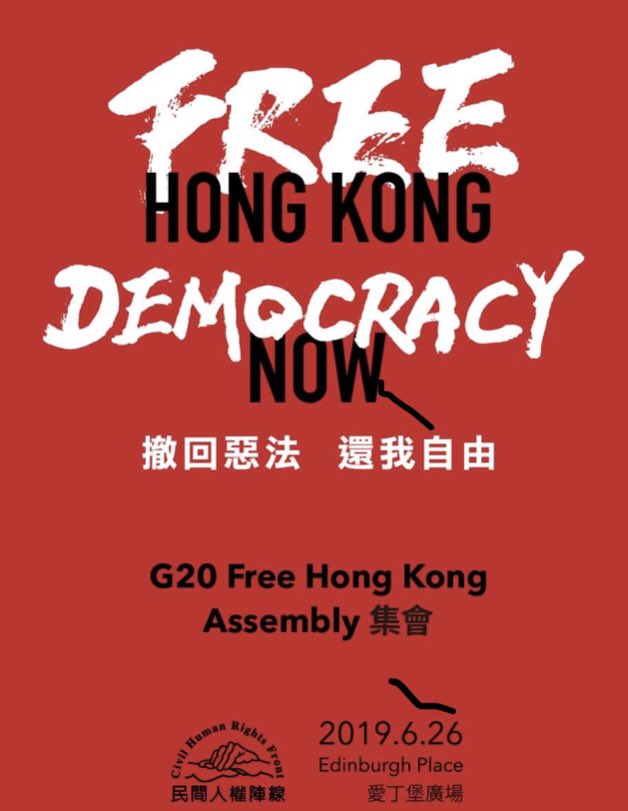
On the morning of the summit, full-page ads appeared in over 10 international newspapers calling on readers to “Stand with Hong Kong,” after an online crowdfunding campaign to place the appeal raised over HK$5 million through public donations, exceeding its original target by HK$2 million.
During the summit, Japanese Prime Minister Shinzo Abe emphasised to Chinese President Xi Jinping the importance of a “free and open Hong Kong, prosperous under One Country, Two Systems,” despite warnings from Beijing’s Assistant Foreign Minister Zhang Jun over raising concerns about the city.
‘Police misconduct and brutality’
For weeks, police were dogged by allegations of misconduct over tactics used during clearance operations, including excessive use of batons and other crowd control tactics.
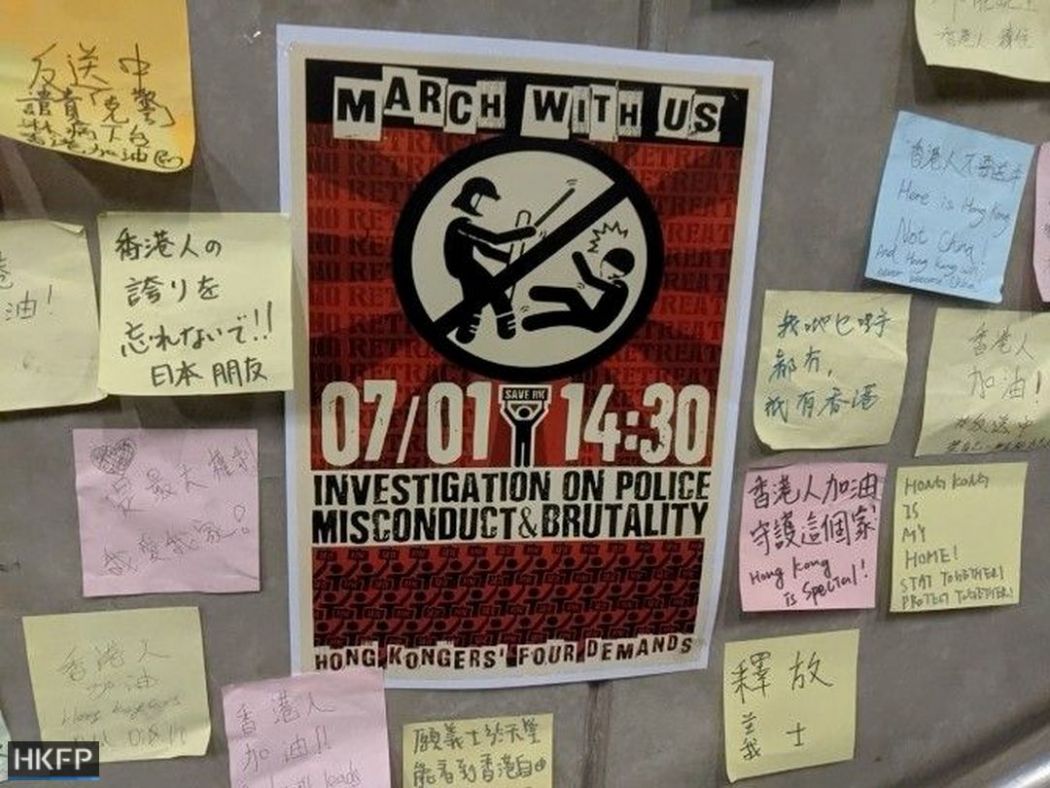
Hong Kong’s police watchdog – the Independent Police Complaints Council – launched an investigation into the force’s handling of the protests last month, though many protesters have since called for an independent commission of inquiry to be formed to examine alleged violence. An investigatory commission formed by the chief executive and led by a retired judge would have the legal power to summon witnesses, but the government has refused to launch one. The IPCC investigation, on the other hand, will have no such powers.
Yellow Raincoat
Weeks after a 35-year-old man protesting the extradition law fell to his death, reportedly leaving a note at the scene, three more cases occurred: on June 29, a 21-year-old female student fell from a Fanling public housing building; on June 30, a 29-year-old women fell from the IFC mall in Central, and a fourth person, a 28-year-old woman, fell from a building on Castle Peak Road in Cheung Sha Wan on July 3.
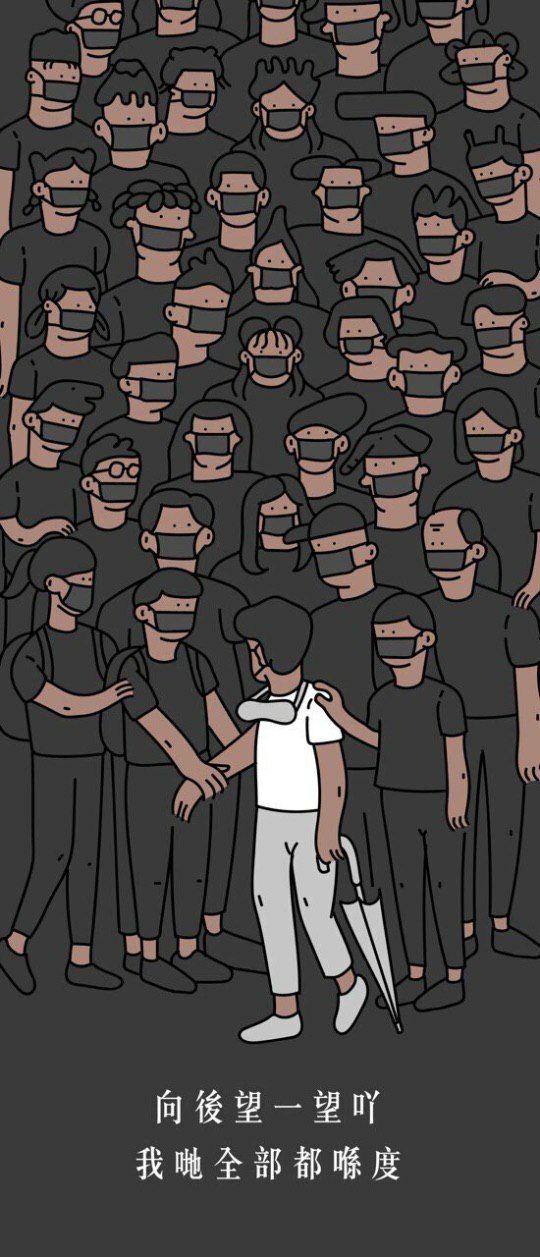
An alternative “black” flag-raising ceremony was scheduled to be held at Edinburgh Place on July 1, in conjunction with an official one usually held at Golden Bauhinia Square. A sign containing details of the event featured a figure in a yellow raincoat – worn by the first protester who died – and one in all-black – the uniform of protesters.

Clashes broke out in the early hours with pepper spray and batons used against protesters. The incident led to the official flag-raising ceremony to be moved indoors for the first time since 1997.

Parallel traders
Under the slogan “Reclaim Sheung Shui,” thousands rallied on July 13 against parallel trading – a recurring problem faced by border towns in the northern New Territories. The practice involves salespeople exploiting a multiple entry visa policy to import tax-free items from Hong Kong across the border, often resulting in a shortage of goods and elevated retail prices, thereby angering local residents.
An explanatory series of posters promoting the protest depicts a row of traders carrying hard side suitcases, frequently used by visitors. People have been filmed using public spaces outside Sheung Shui MTR station to pack their goods before crossing the border, blocking traffic as well as littering the roads with packaging.
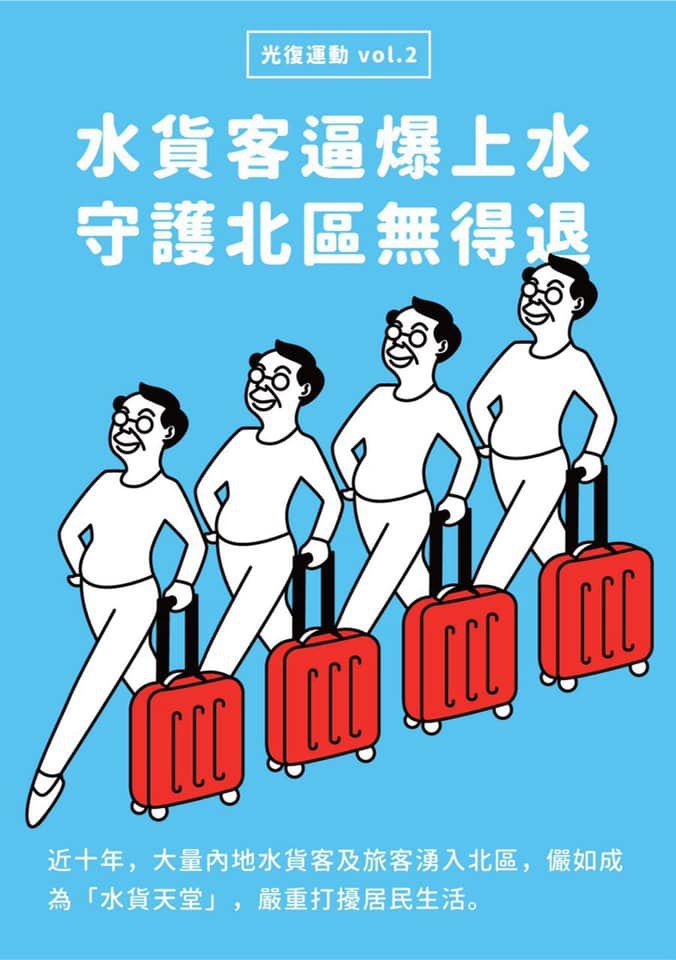
As the original protest – organised by the North District Parallel Imports Concern Group – drew to a close, thousands flooded into thoroughfares around the train station, erecting makeshift barriers as police in riot gear deployed pepper spray to push crowds back.
‘Defend press freedom’
In response to recent allegations of police assault against journalists covering protests, the Hong Kong Journalist Association (HKJA), the Hong Kong Press Photographers Association and five other related groups held a protest on July 14.
A poster promoting the event depicted a high visibility vest with “press” printed on it – a reference to the reflective clothes used to identify journalists working on the field – with the phrase “Using silence to express our anger.” HKJA filed a complaint with the Independent Police Complaints Council on June 17 claiming police had caused bodily harm to 26 journalists during several days of anti-extradition law protests.

The association added that all journalists affected had their press credentials clearly displayed on their helmets or high visibility vests and were not standing among protesters when the incident happened: “The Association has therefore sufficient reasons to believe that those abusive officers were fully aware of their journalists’ identity,” their statement read.
In an escalation of protest actions, anti-extradition law crowds mobilised in Sha Tin – the first of its kind in the New Territories. A poster publicising the event depicted a field of open umbrellas, used to shield protesters from pepper spray while also protecting their identities.
The image as a symbol has its roots in the 2014 pro-democracy protests, lending it the name the Umbrella Movement.
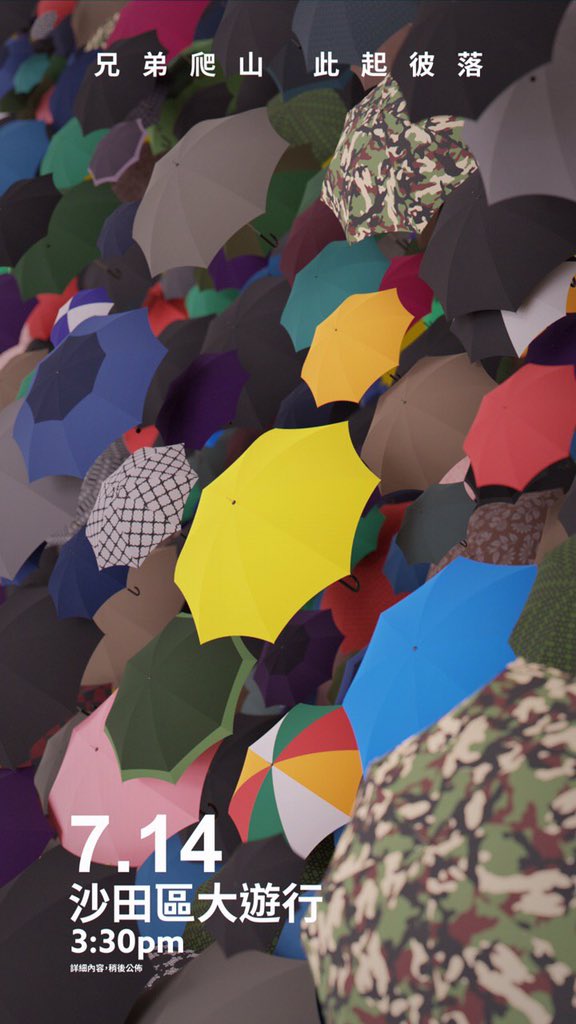
Sha Tin’s occupation ended in running battles as police chased protesters through New Town Plaza, a retail shopping mall positioned among residential tower blocks. Over 40 arrests were made and 22 people hospitalised, four in a serious condition. Ten police officers were injured in the melee – one of whom had part of his finger bitten off, police chief Stephen Lo said.
‘We share the same goal’
A graphic depicts eight characters involved in the anti-extradition law movement: a member of the logistics group, responsible for organising supplies such as water and face masks; a journalist; a first aider; a social worker; a legislative councillor, who netizens have said resembles pro-democracy lawmaker Roy Kwong; a peaceful protester; a member of a publicity group, who updates various Telegram and social media feeds, and a “bravest protester” wearing a helmet, eyemask and gas mask – representing those who are positioned on the protest front lines.
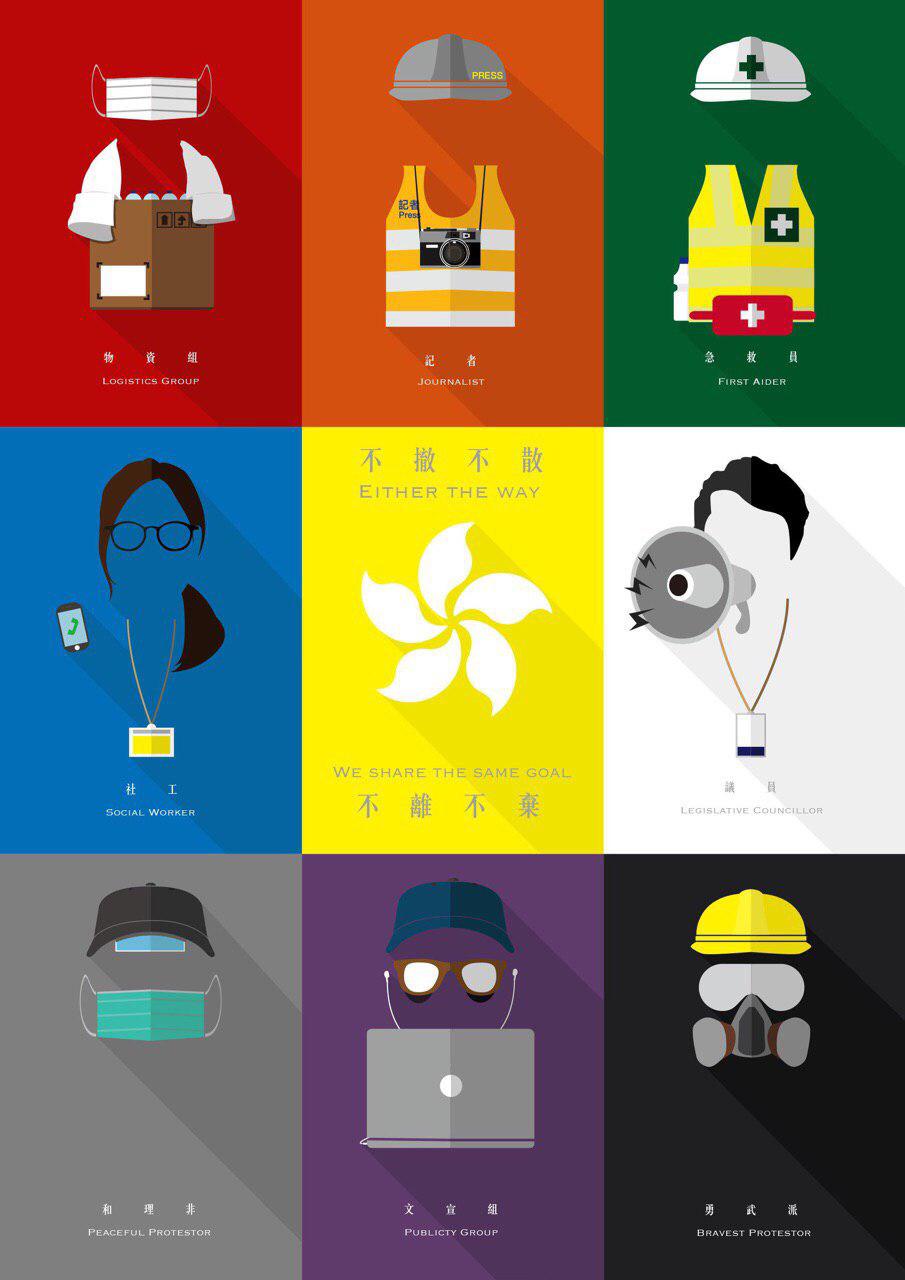
A poster, not designed by CHRF, publicises another anti-extradition march on Sunday using the silhouette of a protester wearing a helmet and a gas mask, while reiterating the protesters’ five demands: complete withdrawal of the extradition bill; retract the use of the term “riot”; drop all criminal charges against protesters; investigate police misconduct, and implement real universal suffrage.

The design of these #antiELAB e-flyers by NewPromoter_bot utilising images from #hongkongprotests and words by Lu Xun 魯迅, icon of modern Chinese literature, reminds me of the aesthetics of In the Mood for Love and Neon Genesis Evangelion #hkcreativity #hongkongprotestart pic.twitter.com/H2zYMMYSzb
— Vivienne Chow (@VivienneChow) July 19, 2019
On Sunday, mobs of armed assailants attacked commuters, residents, journalists and a lawmaker in Yuen Long, hours after the end of an anti-extradition law rally on Hong Kong Island which saw tear gas and rubber bullets used against protesters.
A poster designed after the bloody incident depicted the West Rail Line station – where much of the violence occurred – in the style of an MTR map, with the characters “to freedom” inscribed on it. The rail operator came under fire online for failing to act when travellers were assaulted inside the train carriages during the incident.
Another brilliantly simple, MTR-inspired poster for the march planned for this Saturday afternoon in Yuen Long, in protest against the violent mob attack there on Sunday. pic.twitter.com/GyHj9OXvlu
— Mary Hui (@maryhui) July 24, 2019
Crowds are set to protest in Yuen Long on Saturday over the incident and its handling, taking particular aim the police who stand accused of ignoring distress calls and failing to react promptly.
